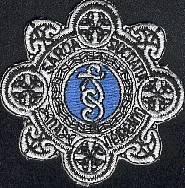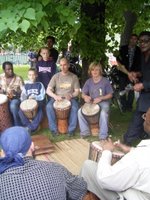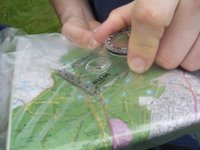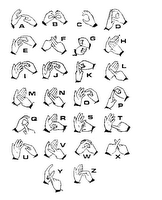 This is the badge of the Irish Police, who are called the Garda Siochana/Guardians of the Peace. My Dad's been one most of my life.
This is the badge of the Irish Police, who are called the Garda Siochana/Guardians of the Peace. My Dad's been one most of my life.
I just spotted, Googling my Dad, that his work was not only discussed in Irish Parliamentary Debates (when he was sergeant) but talks about the same issues that I have just finished my last assignment on this year particularly that of the link between crime and social factors.
Dail Eireann - Volume 433 - 02 July, 1993
Criminal Justice (Public Order) Bill, 1993: Second Stage (Resumed).
The relationship between crime and social and economic conditions was the subject of an interesting study recently by Sergeant Eamon Lynch of the Crime Task Force in Cork which was reported by Mr. Padraig Yeates in The Irish Times of 28 June last. Sergeant Lynch makes a number of very interesting points, the principal one that the rise and drop in crime is directly correlated to the levels of consumption and economic growth. He makes the point, for example, that between 1985 and 1989 crime was fairly static while consumption rose by an average of 3.9 per cent. In 1990, however, consumption rose by only 0.4 per cent and the crime rate jumped by 7 per cent. He makes a similar point in relation to the 1980s. He states that in 1982 spending [983] power dropped by 7.1 per cent, the largest drop in recent Irish economic history, and that the number of crimes shot up by 8,000. He went on to state that five of the six highest crime increases have been associated with minus or zero growth rates. He related that to the whole area of economic conditions and stated that while there was no direct correlation between unemployment and overall crime figures there is a strong correlation between income distribution and crime. He said:I would argue that the extent of crime is crucially dependent on the extent of relative poverty in the community, the size of the gap between the have-a-lots and the have-a-lot-lesses and the interplay of expectations, frustrations, perceptions and misconceptions that offenders have of that gap, and particularly whether they consider that it is narrowing, widening or remaining constant.
Mine is focussing on young people...seeing as I am a youthworker...but is I chose a similar topic to study.
Youth & Community Studies/Youth Justice Assignment Question:Are Social Factors the Most Important Causes of Offending Behaviour Among Young People?Early views on crime such as Darwin’s and other proponents of 'the biological image of behaviour', A. Platt quotes SB. Cooper as saying , promoted the view that 'a large proportion of the unfortunate children that go to make up the great army of criminals are not born right.' The view 'that 'criminals' were a distinct and dangerous class, indigenous to working-class' abounded. The 'cruder concepts of social Darwinism' were to be replaced in the 1890's with such efforts as sociologists like Charles Cooley, who observed that 'criminal behaviour depended as much upon social and economic circumstances as it did upon the inheritance of biological traits.' He considered that the 'criminal class' was 'largely the result of society's bad workmanship upon fairly good material.'(C. Cooley, 1896, quoted by A, Platt, 1974/2002:186)
Moving forward to 1968 and the White Paper, Children in Trouble we get the following view:
"It is probably a minority of children who grow up without ever misbehaving. Frequently such misbehaviour is no more than an incident in the pattern of a child's normal development. But sometimes it is a response to unsatisfactory family or social circumstances, an indication of maladjustment or immaturity or a symptom of a deviant, damaged or abnormal personality." (quoted in J.Clarke, 1975, 2002:134)
Gelsthorpe and Morris (2002:249) question whether we in recent times are seeing a return to the policies introduced in the 1969, Children and Young Person's Act, recasting the offender as a 'victim of social deprivation'. They consider governmental concerns to 'get tough on the causes of crime' which has the Social Exclusion Unit and the Community Development Foundation facilitating 'greater access for young people to the employment market' as well as encouraging 'social improvement in socially deprived areas'.
Bilton et al, (1987:449) see crime, from a positivist perspective, firmly placed by academics in the category of 'social problem' which can be explained in three ways; through biogenic and psychogenic approaches which try to identify the kinds of people that commit crime and how they become those kinds and through sociogenic approaches which 'see criminal behaviour as socially acquired'. While the former, non sociological explanations have been popular 'in the eyes of the media, politicians, moralists and...many...involved...with criminals' it has been acknowledged by sociologists to be 'unsatisfactory' and the necessity of the latter, 'a sociological explanation of crime' has been identified (Bilton et al, 1987:451). As criminal behaviour, according to Bilton et al, is not 'randomly distributed by genes or personality but follows a consistent social pattern'...there is a 'basic acceptance of social influences and social processes as important in criminal behaviour'.
Durkheim argues that 'social phenomena' cannot be 'reduced to individual state, either biological or psychological, but depends instead on social factors', made up of 'social facts' which he maintains are 'external, coercive and objective' (Abercrombie et al, 2000:322). A distinction can be made, according to Abercrombie et al (2000:326), however, between 'social problems' and 'social facts', where problems are the result of 'social change'. This social change can create conflict between two groups in which 'one group succeeds in wining public acceptance of its claim that the other's behaviour should be labelled as problematic' causing the 'moral panics' that frequent our media. This illustrates how, then the 'media of communication help define social problems and create public anxiety' (Ibid). This, similarly, can be seen in such high profile cases as the Bulger case.
Sheila Brown (1998:50) quotes the judge in the Bulger case citing 'violent video films' as a cause 'in part' of their behaviour and, as Smith (1994:227) puts it 'no mention of any other issues that might be a factor in young people committing serious crime' despite there being 'no mention in evidence of any videos'. However, The Sun was convinced; Brown (1998:51) tells us, that on the 26th of November 1993 they printed 'the image of Chucky consumed in flames, declaring: 'For the sake of all our kids...BURN YOUR VIDEO NASTY.' This sort of media, surrounding the case, a cause of the 'periodic "moral panics" about youth crime (Muncie et al, 2002:19), coupled with the Newson report increased the public's perception of, 'the child villain', as Brown puts it, 'innocence polluted by video nasties'. Thus when arbitrary factors as this are taken into consideration despite there being no evidence to back up the claim the real factors can be masked. According to Abercrobie et al (2002:326), this kind of media masking leads to 'many official definitions of social problems' being believed to be derived from 'the personal characteristics of individuals rather than from structural features of the social system over which individuals have little influence' (Abercrombie et al, 2000:322)
Griffin, C (2004:14) sees 'traditional' or 'mainstream approaches' tending to adopt various forms of the 'victim-blaming thesis', in which young people are represented as the cause of specific 'social problems' and that such problems could be 'alleviated if those young people who are most affected would only change their attitudes, appearance or behaviour'. Whereas what she calls the 'radical perspective' she considers is more likely 'to focus on the wider social systems in which young people live, economic, political and cultural, looking at relations of domination and subordination around gender, 'race', class, sexuality and (less frequently) disability as well as age.'
The 'traditional position' Goldson (2002:388) purports, of the Government tending to 'connect criminal justice with social justice', has been 'digressed from' by playing down the links between 'economic factors and rising crime'. According to Muncie and Hughes (2002:10), at the 'heart' of Labour's new youth justice are factors such as 'family breakdown, poor parental control, failing child rearing practices and a dependency culture'. However '[m]uch of this flies in the face of repeated research findings that young people in trouble with the law have complex and systematic patterns of disadvantage which lie beyond any incitement to find work, behave properly or take up the "new opportunities" on offer' (Muncie and Hughes, 2002:10).
A summary of Farrington's (1996) report cites the major risk factors for youth crime as the following:
- low income and poor housing
- living in deteriorated inner city areas
- a high degree of impulsiveness and hyperactivity
- low intelligence and low school attainment
- poor parental supervision and harsh and erratic discipline
- parental conflict and broken families
At the top of his 'major risk factors for juvenile offending' is the following:
Prenatal and perinatal: early child-bearing increases the risks of such undesirable outcomes for children as low school attainment, antisocial behaviour, substance use and early sexual activity. An increased risk of offending among children of teenage mothers is associated with low income, poor housing, absent fathers and poor child-rearing methods
However, Griffin (2004:15) cites a recent study of young women in Britain who became pregnant in their teenage years where Ann Phonix (1991) argues 'that when economic indices are held constant, many of the educational, psychological, and social problems experienced by the children of 'young mothers' evaporate.' Griffin contends, 'that is, it is not the youth or the single status of these children's mothers that should be a cause for concern, but the poverty into which they are born, and which their mothers struggle to overcome as best they can.'
With the highest percentage of children in poverty in Europe and known factors such as 'family difficulties and prior contact with the care system', Muncie and Hughes contend that 'any inclusionary programme which does not simultaneously advocate a redistribution of power wealth and opportunity is likely to be seriously flawed' (2002:10). McGhee et al (1996, 2002:236) speak of the 'current desire' to 'remove young offenders from child care decision making to a justice model' as risking 'stepping back into failed past experiments rather than addressing the social and family conditions which may contribute towards offending behaviour.'
In that vein, J. Muncie (2004) considers it significant that the Welsh Assembly chose to locate youth justice services within Health and Social Services rather than Crime Prevention. As early as the 1960's, according to the Home Office, it was recognised that 'the requirement to have regard to the welfare of the child, and the various ways in which the court may deal with an offender, suggests a jurisdiction which is not criminal.' This, it was stated, was because 'criminal responsibility is focussed on an allegation about some particular act isolated from the character and needs of the defendant, whereas welfare depends on a complex of personal, family and social considerations.' (cited by Brown, 1998:57)
An outcome of this lack of focus on welfare leads to what Brown (1998:96) considers Anderson et al's (1994:158) 'vicious circle of young people and crime' where as she contends, indifference to their 'victimisation' means they 'develop their own strategies for coping with crime' such as 'carrying weapons for protection' reinforcing the 'youth as problem' cycle to be reinforced. Exploring, Morgan and Zedner's (1992:6) 'victimisation of children seen solely in terms of child abuse' meaning concern about this developing 'largely outside a criminological framework', Brown (1998:96) considers that '[c]hildren and young people have to earn their status as victims whereas they are eagerly ascribed their status as offenders.'
Seabrook (2002:112) tackles the idea of 'criminal classes' in 'affluent societies' where he recognises how the 'poor' in these societies, in the 'injustice which imprisons them in prison like suburbs, public housing schemes, bidonvilles, favelas, barrios, and peripheral dumping grounds which characterise the cities of the world revolt against the 'social injustice within societies whose wealth has been prodigious and in which certain individuals have been conspicuously rewarded.' He sees those for whom 'social hope' had been 'cancelled', who recognise that the 'boy next door who becomes a football star' or the 'girl who won the talent competition on TV' are 'very little different from themselves' and with 'no possibility of social improvement, they take the law into their own hands.' Similar to what Bilton et al (1987:483) might term a kind of 'sociology of the underdog', Seabrook sees, crime, therefore as related to poverty in the sense of the 'structures of inequality within societies distinguished by their...wealth' (Seabrook, 2002:113-114). Similarly, Haralambos (1983:254) cites Cohen's theory on social class differences in crime, identifying motives to be material gain, prestige (from peers/success in crime), 'status frustration' and as 'the chance to hit back at wider society which has denied many ...the opportunity to become successful.' 'Delinquency is [a]... response[...] which people... make to prolonged hardship and frustration.' (Donnison, 1977)
In summary and according to Mathiesen, T (1990,2002:382) '[c]urrent offenders ending up in prisons...tend to show signs of extreme poverty in three generalised respects':
Their material situation is regularly acute, and coupled with illness, drug addiction and distress.
Their symbolic standing, in their own eyes and in the eyes of others is the lowest possible.
And their social situation is characterized by isolation and cultural poverty.
Mathiesen (1990,2002:383) goes on to propose ways in which these three areas can be tackled. He considers that the 'material standing of these people may be fundamentally changed through relatively simple and fairly modest material inputs' and their 'symbolic standing and social situation [though] requires more imagination...rituals...which confer new standing and status...' For 'sociological correlates to intensive criminal behaviour' he would advocate, 'compensatory mechanisms' to cancel out correlates, with amongst other things new housing, educational and youth policies as well as 'intensified policing' to 'control before crime occurs' (Ibid).
From an alternative perspective Radical criminology would consider the power structures which allow 'economic and socio-political forces' to operate in the construction and application of 'deviant' or 'criminal' labels (Bilton et al 1987:484). Marxists accuse us of accepting 'official definitions of crime and deviance' thus meaning an 'acceptance of an existing social order by restricting analysis to a predefined range of subject matter…inhibit[ing] the questioning of the propriety of other areas of behaviour.' This is seen as how 'capitalism 'creates' crime in its legal definitions' while ignoring the 'inequalities of capitalism' which produce a 'propertied and powerful class and the propertyless and powerless classes' and in turn what Liazos (1972:109) is quoted as calling 'covert institutionalised violence' such as 'exploitation, poverty and imperialism' (Bilton et al, 1987:484)
Gelsthorpe and Morris (2002:240) point out the age of criminal responsibility in England and Wales is ten. Those under ten 'cannot be found guilty of a criminal offence' and those between ten and thirteen are 'presumed in law to be doli inpax (incapable of criminal intent)'. This recognises, as Gelsthorpe and Morris (2002:241) tell us, that under fourteen 'should not be considered as fully criminally responsible as adults' but it still remains that ten year olds behaving the same way in other parts of western Europe will not be classed as criminals, as they are in England and Wales with the age of criminal responsibility set as low as ten. It is down to what we consider should be the definition of a criminal and crime.
Scraton and Haydon (2002:324) consider that the 1998 Crime and Disorder Act 'criminalises children, young people and their parents' and they call for the age of criminal responsibility to be raised to sixteen 'in line with other social responsibilities within UK legislation.' This would mean the definition of 'acts currently labelled as 'crimes' or 'offences' as outside the criminal justice process if committed by children or young people under sixteen, redefining such acts as 'inappropriate or causing harm'. This would involve acknowledging that such behaviour 'may be ways of coping with or reacting to, their experience of social injustice...' This, increasing of the age of criminal responsibility to 16, was in fact proposed in the 1965 White Paper, The Child, the Family and the Young Offender (Home Office 1965, cited by Brown, 1998:59). Minor offences were seen as 'part of the normal process of growing up' and the more serious were done by 'the victims of a deprived and unhappy home'. This recognised social factors importance to the cause of crime and proposed that 'non-judicial Family Councils [would] be in place of the Juvenile Courts for young people under 16' causing, in essence 'juvenile offending [to be] effectively decriminalised.' Gelsthorpe and Morris (2002:242) point out, in fact that although 'minor offences' can be associated with adolescence, the lesser number of persistent offender's crimes are 'unrelated to age' but are 'characterised by an early onset of offending and chaotic lives in which poverty, violence, neglect, abuse and school failure.'
Considering offending among young people, findings support the importance of social factors as a cause of that behaviour, in particular as Ackerman's (1998) research indicates 'crime is significantly related to poverty and its associated conditions and processes.' Pitts, J. & Hope (1997) focus 'not only on whether the State could or should intervene economically to ameliorate the causes of the "new poverty" but also on how the State should address the increasing rates of "social dislocation"-including youth crime...associated with its emergence.' Donnison (1997) contends that 'if our aim is to reduce crime, its economic and social context must first be understood; then changed'.
Equally, as Per-Olof Wikstrom, from SCOPIC (Social contexts of pathways into crime) maintains:
'Too often different approaches - the study of social factors and individual characteristics, for instance - have been dealt with separately in research, and this problem has been reflected in crime prevention initiatives with similar limitations. We need a more integrated approach, understanding how different factors interact and how these interactions vary in different times and places.'
BIBLIOGRAPHY
Ackerman, W. V. (1998) Socioeconomic Correlates of Increasing Crime Rates in Smaller Communities. The Professional Geographer 50 (3), 372-387. doi: 10.1111/0033-0124.00127
Abercrombie et al, (2000) The Penguin Dictionary of Sociology, Fourth Edition, Penguin Books Ltd, London
Bilton, T. et al, (1987) Introductory Sociology (34-147), London, The Macmillan Press Ltd
Clarke, J. (1975, 2002) The 3 Rs – repression, rescue and rehabilitation: ideologies of control for working class youth, Youth Justice Critical Readings, The Open University, Sage Publications
Corby, B (2004) The Mistreatment of the young, Youth in Society, Open University, London
Donnison, D (1997) Creating a Safer Society. Social Policy & Administration 31 (5), 3-21. doi: 10.1111/1467-9515.00072
Farrington, D. (1996) Understanding and Preventing Youth Crime, Social Policy Research 93 (April 1996), Joseph Rowntree Foundation, York Publishing Sevices
http://www.jrf.org.uk/KNOWLEDGE/FINDINGS/socialpolicy/SP93.asp
Gelsthorpe, L. & Morris, A. (2002) Restorative youth justice, The last vestiges of welfare? Youth Justice Critical Readings, The Open University, Sage Publications
Goldson, B. (2002) New Punitiveness, The Politics of Child Incarceration, Youth Justice Critical Readings, The Open University, Sage Publications
Griffin, C (2004) Representations of Youth, Youth in Society, Open University, London
Haralambos, M. et Al (1983), Sociology a new approach, Causeway press Ltd.
Seabrook, J (2002) Class, Caste & Hierarchies, New Internationalist Publications Ltd, Oxford
Thomson et al (2004), Introduction to the Second Edition, Youth in Society, Open University, London
Mathieson, T. (2002) The Future of Imprisonment, Youth Justice Critical Readings, The Open University, Sage Publications
McGhee et al (1996, 2002) Children’s Hearings & Children inTtrouble, Youth Justice Critical Readings, The Open University, Sage Publications
Muncie, J. & Hughes, G. (2002) Modes of Youth Governance, Youth Justice Critical Readings, The Open University, Sage Publications
Pitts, J. & Hope, T. (1997) The Local Politics of Inclusion: The State and Community Safety. Social Policy & Administration 31 (5), 37-58. doi: 10.1111/ 1467-9515.00074
Platt, A. (1974, 2002) The Triumph of Benevolence, Youth Justice Critical Readings, The Open University, Sage Publications
Wikström, P. (SCOPIC) Social Contexts of Pathways into Crime) Fundef by the Economic and Social research Council http://www.scopic.ac.uk/
 I saw X-Men today but I saw stranger things in real life today.
I saw X-Men today but I saw stranger things in real life today.

































